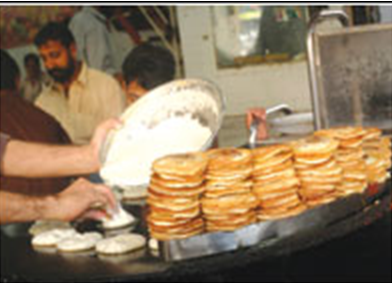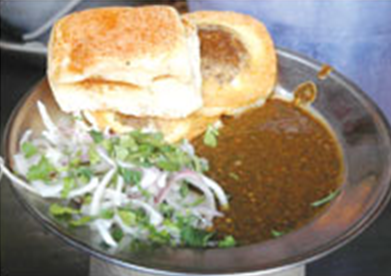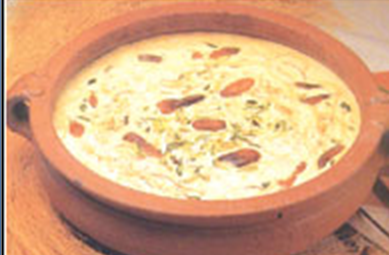Pakistani Cuisine
This is a collection of articles archived for the excellence of their content. Readers will be able to edit existing articles and post new articles directly |
Bun kebab
FOOD FOR THOUGHT: The feisty little bun-kebab
By Qasim A. Moini
Although a simple patty in a bun, bun-kebabs perhaps, are a strong symbol of the class struggle, as they are the proletariat’s favoured snack served up from countless stalls dotting each and every locality in the sprawling metropolis of Karachi.
From Tariq Road to Teen Hatti and beyond, bun-kebabs of varying types and quality can be found, usually sold from a souped-up push-carts or some other almost mobile structure; one can have a quick, tasty snack on the go for under Rs20.
On the other hand, the fare that the multinational burger and chicken franchises peddle costs about five times as much, served up by a smiling, uniformed staffer, under the watchful, Orwellian gaze of a pasty faced clown or goateed colonel. Whereas the bun kebab symbolises all things Urdu medium, the burger, at least in the Pakistani context, represents all things elite and western (read American), and the cultural baggage this entails.
But class divisions and the role food plays in defining these is perhaps a topic for another day. Instead, I’ll let this be a humble homage to that uncrowned king of Pakistani street food: the bun kebab.
For the sake of those who might have been living under a rock for the past few decades, I’ll offer a quick description of what a bun kebab is: in simplest terms, it is a kebab, or ground meat patty, enclosed within a bun. But isn’t that essentially what a burger is? Here, my friends, is the catch. You see, the burger and bun kebab are like two long-lost twins who have rediscovered themselves after a lifetime apart. Though they may share the same basic structure, their culinary evolution has ensured their individual identity.
Even though many bun kebab-wallahs, perhaps in moments of self-doubt amplifying a latent inferiority complex, refer to their concoctions as burgers, the difference between burgers and bun-kebabs is a fine one. And for the discerning foodie, this fine difference is as clear as day.
The very aroma of a bun kebab being prepared at a roadside stall sets it apart from a burger. The trained nose of any sensitive gastronome will detect the scent of a bun kebab from a mile away. And delving a little deeper into the nature of bun-kebabs, one realizes just how much of a separate identity this snack has carved out for itself.
Though labelled a ‘kebab’, in my culinary adventures across this city, I have noticed that the presence of meat in bun-kebabs is negligible. And considering the appalling hygiene standards of most of our foods — both street fare and the stuff served up at proper establishments — perhaps this is a blessing in disguise. Still, the bun kebab-wallah will usually offer you two choices: a meat version or a potato patty. After you’ve made this crucial choice, you can also choose to add fried egg, which I would highly recommend, as it adds a definite kick to the final product.
After these details are out of the way, the chap will start frying your patty and your egg, along with toasting the bun. This, one must say, also enhances the flavour of the bun kebab tremendously, as the crisp bun complements the mushy contents within perfectly. Apart from the aforementioned ingredients, most bun kebab ‘chefs’ also add a generous helping of onions along with a sliced cucumber or two, with some even throwing in a slice of tomato, though this is rare.
But what would a bun kebab be without the condiments? The usual suspects are a somewhat a dodgy ketchup-looking stuff along with a tangy chutney (coriander, green chillies or tamarind are the secret ingredients, methinks) that simply takes the cake. Once the hot-off the-stove bun kebab is doused in this chutney, new dimensions of taste open up.
Some bun kebab-wallahs have started adding desi French fried potatoes, but for some reason it just doesn’t work; instead it ends up spoiling the experience. Though burgers and fries are a somewhat the most appropriate combination, bun-kebabs and chips is just not the done thing.
And since I’ve praised the humble bun kebab to high heaven, I feel it is my civic duty to also inform you about the hazards involved. You see, even though the bun kebab is an awami food, the hygiene standards at many joints selling the stuff are abysmal. Here, the burgers have a clear edge as, even though they may clog your arteries, they are mostly prepared in hygienic conditions.
Bun kebab-wallahs, on the other hand, are far less concerned with health and safety requirements. As with all street food, just use your common sense. If there is a steam of raw sewage flowing next to the bun kebab thela or if your patty is being flavoured with noxious vehicle exhaust free of cost, look for another joint, unless of course you want to battle with a nasty bout of gastroenteritis.
Eid Table
The Eid Table
By Saira Abdullah
see MUZÂFAR n SHEER KHURMA, SPECIAL


